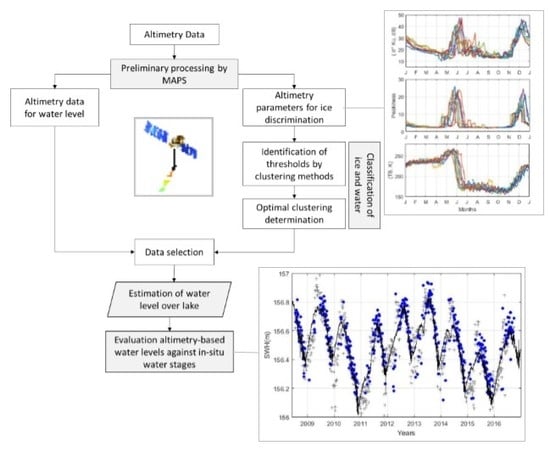Improving the Estimation of Water Level over Freshwater Ice Cover using Altimetry Satellite Active and Passive Observations
Abstract
:1. Introduction
2. Dataset Presentation and Methods
2.1. Study Area
2.2. Dataset
2.2.1. Altimetry Data, Jason-2 Mission
2.2.2. In situ Water Levels
2.2.3. NDSI from MODIS
2.3. Method
2.3.1. Preliminary Processing Using MAPS
2.3.2. Classification of Water and Ice
- Identification of Thresholds by Clustering Methods
- Optimal clustering determination
- Validation of thresholds using NDSI from MODIS
2.3.3. Estimation of Water Level over Lake
2.3.4. Evaluation of Altimetry-based Water Levels from in-situ Water Levels
3. Results
3.1. Temporal Evolution of Jason-2 Parameters
3.2. Along-Track Clustering of Surface States of the Lakes
3.3. Clustering Analysis
3.4. Evaluation of the Thresholds using NDSI from MODIS
3.5. Evaluation of Water Levels Estimated under Thresholds of Open Water
4. Discussion
5. Conclusions
Author Contributions
Funding
Acknowledgments
Conflicts of Interest
Appendix A
References
- Vincent, W.F.; Daniel, M.; Reinhart, P.; Isabelle, L.; Muir, D.C.G.; Young, K.L.; Bégin, Y. Chapter 4. Freshwater resources in a changing environment. In Integrated Regional Impact Studies; Allard, M., Lemay, M., Eds.; ArcticNet: Quebec City, QC, Canada, 2012; pp. 137–155. [Google Scholar]
- Prowse, T.D.; Ommanney, C.S. Northern hydrology: Canadian perspectives; Institut national de recherche en hydrologie (Canada): Quebec City, QC, Canada, 1990; pp. 1–309. [Google Scholar]
- Prowse, T.; Alfredsen, K.; Beltaos, S.; Bonsal, B.; Duguay, C.; Korhola, A.; McNamara, J.; Vincent, W.F.; Vuglinsky, V.; Weyhenmeyer, G.A. Arctic Freshwater Ice and Its Climatic Role. Ambio 2011, 40, 46–52. [Google Scholar] [CrossRef] [Green Version]
- Lin, P.; Yang, Z.L.; Cai, X.; David, C.H. Development and evaluation of a physically-based lake level model for water resource management: A case study for Lake Buchanan, Texas. J. Hydrol. Reg. Stud. 2015, 4, 661–674. [Google Scholar] [CrossRef] [Green Version]
- Stammer, D.; Cazenave, A. Satellite Altimetry over Oceans and Land Surfaces; Stammer, D., Cazenave, A., Eds.; CRC Press: Boca Raton, FL, USA; Taylor & Francis: London, UK, 2017; p. 681. [Google Scholar]
- Michailovsky, C.-I.; McEnnis, S.; Berry, P.; Smith, R.; Bauer-Gottwein, P. River monitoring from satellite radar altimetry in the Zambezi River basin. Hydrol. Earth Syst. Sci. 2012, 16, 2181–2192. [Google Scholar] [CrossRef] [Green Version]
- Baup, F.; Frappart, F.; Maubant, J. Combining high-resolution satellite images and altimetry to estimate the volume of small lakes. Hydrol. Earth Syst. Sci. 2014, 18, 2007–2020. [Google Scholar] [CrossRef] [Green Version]
- Tseng, K.-H.; Shum, C.K.; Yi, Y.; Fok, H.S.; Kuo, C.-Y.; Lee, H.; Cheng, X.; Wang, X. Envisat Altimetry Radar Waveform Retracking of Quasi-Specular Echoes over the Ice-Covered Qinghai Lake. Terr. Atmos. Ocean. Sci. 2013, 24, 615. [Google Scholar] [CrossRef] [Green Version]
- Crétaux, J.-F.; Nielsen, K.; Frappart, F.; Papa, F.; Calmant, S.; Benveniste, J. Hydrological applications of satellite altimetry: rivers, lakes, man-made reservoirs, inundated area. In Satellite Altimetry Over Oceans and Land Surfaces; Earth Observation of Global Changes; Stammer, D., Cazenave, A., Eds.; CRC Press: Boca Raton, FL, USA, 2017; pp. 459–504. [Google Scholar]
- Birkett, C.M. The contribution of Topex/Poseidon to the global monitoring of climatically sensitive lakes. J. Geophys. Res. 1995, 100, 25179–25204. [Google Scholar] [CrossRef]
- Frappart, F.; Calmant, S.; Cauhope, M.; Seyler, F.; Cazenave, A. Preliminary results of ENVISAT RA-2-derived water levels validation over the Amazon basin. Remote Sens. Environ. 2006, 100, 252–264. [Google Scholar] [CrossRef] [Green Version]
- Kouraev, A.V.; Semovski, S.V.; Shimaraev, M.N.; Mognard, N.M.; Legresy, B.; Remy, F. The ice regime of Lake Baikal from historical and satellite data: Relationship to air temperature, dynamical, and other factors. Limnol. Oceanogr. 2007, 52, 1268–1286. [Google Scholar] [CrossRef]
- Kouraev, A.V.; Shimaraev, M.N.; Buharizin, P.I.; Naumenko, M.A.; Crétaux, J.-F.; Mognard, N.; Legrésy, B.; Rémy, F. Ice and Snow Cover of Continental Water Bodies from Simultaneous Radar Altimetry and Radiometry Observations. Surv. Geophys. 2008, 29, 271–295. [Google Scholar] [CrossRef]
- Kouraev, A.V.; Zakharova, E.A.; Rémy, F.; Suknev, A.Y. Study of Lake Baikal Ice Cover from Radar Altimetry and In–Situ Observations. Mar. Geod. 2015, 38, 477–486. [Google Scholar] [CrossRef]
- Kouraev, A.V.; Papa, F.; Mognard, N.M.; Buharizin, P.I.; Cazenave, A.; Cretaux, J.-F.; Dozortseva, J.; Remy, F. Sea ice cover in the Caspian and Aral Seas from historical and satellite data. J. Mar. Syst. 2004, 47, 89–100. [Google Scholar] [CrossRef]
- Kouraev, A.V.; Papa, F.; Mognard, N.M.; Buharizin, P.I.; Cazenave, A.; Cretaux, J.-F.; Dozortseva, J.; Remy, F. Synergy of active and passive satellite microwave data for the study of first-year sea ice in the Caspian and Aral seas. IEEE Trans. Geosci. Remote Sens. 2004, 42, 2170–2176. [Google Scholar] [CrossRef]
- Lambin, J.; Morrow, R.; Fu, L.-L.; Willis, J.K.; Bonekamp, H.; Lillibridge, J.; Perbos, J.; Zaouche, G.; Vaze, P.; Bannoura, W.; et al. The OSTM/Jason-2 Mission. Mar. Geod. 2010, 33, 4–25. [Google Scholar] [CrossRef]
- Dumont, J.; Rosmorduc, V.; Carrere, L.; Picot, N.; Bronner, E.; Couhert, A.; Desai, S.; Bonekamp, H.; Figa, J.; Lillibridge, J.; et al. OSTM / Jason-2 Products Handbook; CNES: Ramonville St Agne, France, 2015. [Google Scholar]
- Hamilton, A.S.; Moore, R.D. Quantifying Uncertainty in Streamflow Records. Can. Water Resour. J. Rev. Can. Ressour. Hydr. 2012, 37, 3–21. [Google Scholar] [CrossRef]
- Hall, D.K.; Riggs, G.A.; Salomonson, V.V. Development of methods for mapping global snow cover using moderate resolution imaging spectroradiometer data. Remote Sens. Environ. 1995, 54, 127–140. [Google Scholar] [CrossRef]
- Riggs, G.A.; Hall, D.K.; Salomonson, V. V MODIS snow products user guide. NASA Goddard Sp. Flight Cent Rep. 2006, 1–45. [Google Scholar]
- Riggs, G.A.; Hall, D.K.; Román, M.O. MODIS Snow Products Collection 6 User Guide. NASA Goddard Sp. Flight Cent. Rep. 2016, 1–66. [Google Scholar]
- Pavelsky, T.M.; Smith, L.C. Spatial and temporal patterns in Arctic river ice breakup observed with MODIS and AVHRR time series. Remote Sens. Environ. 2004, 93, 328–338. [Google Scholar] [CrossRef]
- Ault, T.W.; Czajkowski, K.P.; Benko, T.; Coss, J.; Struble, J.; Spongberg, A.; Templin, M.; Gross, C. Validation of the MODIS snow product and cloud mask using student and NWS cooperative station observations in the Lower Great Lakes Region. Remote Sens. Environ. 2006, 105, 341–353. [Google Scholar] [CrossRef]
- Frappart, F.; Fatras, C.; Mougin, E.; Marieu, V.; Diepkilé, A.T.; Blarel, F.; Borderies, P. Radar altimetry backscattering signatures at Ka, Ku, C, and S bands over West Africa. Phys. Chem. Earth Parts A/B/C 2015, 83–84, 96–110. [Google Scholar] [CrossRef]
- Normandin, C.; Frappart, F.; Diepkilé, A.T.; Marieu, V.; Mougin, E.; Blarel, F.; Lubac, B.; Braquet, N.; Ba, A. Evolution of the Performances of Radar Altimetry Missions from ERS-2 to Sentinel-3A over the Inner Niger Delta. Remote Sens. 2018, 10, 833. [Google Scholar] [CrossRef] [Green Version]
- Fu, L.-L.; Cazenave, A. Satellite Altimetry and Earth Sciences: A Handbook of Techniques and Applications; Academic Press: Cambridge, MA, USA, 2001; pp. 1–463. [Google Scholar]
- Wingham, D.J.; Rapley, C.G.; Griffiths, H. New Techniques in Satellite Altimeter Tracking Systems. In Proceedings of the Digest—International Geoscience and Remote Sensing Symposium (IGARSS), Zurich, Switzerland, 8 September 1986; pp. 1339–1344. [Google Scholar]
- Sulistioadi, Y.B.; Tseng, K.-H.; Shum, C.K.; Hidayat, H.; Sumaryono, M.; Suhardiman, A.; Setiawan, F.; Sunarso, S. Satellite radar altimetry for monitoring small rivers and lakes in Indonesia. Hydrol. Earth Syst. Sci. 2015, 19, 341–359. [Google Scholar] [CrossRef] [Green Version]
- Yi, Y.; Kouraev, A.V.; Shum, C.K.; Vuglinsky, V.S.; Crétaux, J.-F.; Calmant, S. The performance of altimeter waveform retrackers at Lake Baikal. TAO Terr. Atmos. Ocean. Sci. 2013, 24, 513. [Google Scholar] [CrossRef] [Green Version]
- Chelton, D.B.; Ries, J.C.; Haines, B.J.; Fu, L.-L.; Callahan, P.S. Chapter 1 Satellite Altimetry. In Satellite Altimetry; International Geophysics; Academic Press: Cambridge, MA, USA, 2001; pp. 1–131. [Google Scholar]
- Pavlis, N.K.; Holmes, S.A.; Kenyon, S.C.; Factor, J.K. The development and evaluation of the Earth Gravitational Model 2008 (EGM2008). J. Geophys. Res. Solid Earth 2012, 117, 1–38. [Google Scholar] [CrossRef] [Green Version]
- Mercier, F.; Rosmorduc, V.; Carrere, L.; Thibaut, P. Coastal and Hydrology Altimetry Product (PISTACH) Handbook; CNES: Toulouse, France, 2010; pp. 1–64. [Google Scholar]
- Hartigan, J.A.; Wong, M.A. Algorithm AS 136: A K-Means Clustering Algorithm. Applied Statistics. 1979, 28, 100. [Google Scholar] [CrossRef]
- Rokach, L.; Maimon, O. Clustering Methods. In Data Mining and Knowledge Discovery Handbook; Springer: New York, NY, USA, 2005; pp. 321–352. [Google Scholar]
- Rousseeuw, P.J. Silhouettes: A graphical aid to the interpretation and validation of cluster analysis. J. Comput. Appl. Math. 1987, 20, 53–65. [Google Scholar] [CrossRef] [Green Version]
- Calinski, T.; Harabasz, J. A dendrite method for cluster analysis. Commun. Stat. Theory Methods 1974, 3, 1–27. [Google Scholar] [CrossRef]
- Saitta, S.; Raphael, B.; Smith, I.F.C. A comprehensive validity index for clustering. Intell. Data Anal. 2008, 12, 529–548. [Google Scholar] [CrossRef] [Green Version]
- Sarmiento, S.E.; Khan, S.D. Spatial–Temporal Variability of Great Slave Lake Levels From Satellite Altimetry. IEEE Geosci. Remote Sens. Lett. 2010, 7, 426–429. [Google Scholar] [CrossRef]
- Brown, G. The average impulse response of a rough surface and its applications. IEEE Trans. Antennas Propag. 1977, 25, 67–74. [Google Scholar] [CrossRef]
- Wang, H.; Chu, Y.; Huang, Z.; Hwang, C.; Chao, N. Robust, Long-term Lake Level Change from Multiple Satellite Altimeters in Tibet: Observing the Rapid Rise of Ngangzi Co over a New Wetland. Remote Sens. 2019, 11, 558. [Google Scholar] [CrossRef] [Green Version]
- Santos da Silva, J.; Calmant, S.; Seyler, F.; Rotunno Filho, O.C.; Cochonneau, G.; Mansur, W.J. Water levels in the Amazon basin derived from the ERS 2 and ENVISAT radar altimetry missions. Remote Sens. Environ. 2010, 114, 2160–2181. [Google Scholar] [CrossRef]
- Frappart, F.; Biancamaria, S.; Normandin, C.; Blarel, F.; Bourrel, L.; Aumont, M.; Azemar, P.; Vu, P.-L.; Le Toan, T.; Lubac, B.; et al. Influence of recent climatic events on the surface water storage of the Tonle Sap Lake. Sci. Total Environ. 2018, 636, 1520–1533. [Google Scholar] [CrossRef] [PubMed] [Green Version]
- Pfeffer, J.; Seyler, F.; Bonnet, M.P.; Calmant, S.; Frappart, F.; Papa, F.; Paiva, R.C.D.; Satgé, F.; Silva, J.S. Da Low-water maps of the groundwater table in the central Amazon by satellite altimetry. Geophys. Res. Lett. 2014, 41, 1981–1987. [Google Scholar] [CrossRef] [Green Version]
- Medina, C.E.; Gomez-Enri, J.; Alonso, J.J.; Villares, P. Water level fluctuations derived from ENVISAT Radar Altimeter (RA-2) and in-situ measurements in a subtropical waterbody: Lake Izabal (Guatemala). Remote Sens. Environ. 2008, 112, 3604–3617. [Google Scholar] [CrossRef]
- Zakharova, E.A.; Kouraev, A.V.; Rémy, F.; Zemtsov, V.A.; Kirpotin, S.N. Seasonal variability of the Western Siberia wetlands from satellite radar altimetry. J. Hydrol. 2014, 512, 366–378. [Google Scholar] [CrossRef]
- Kim, J.W.; Lu, Z.; Lee, H.; Shum, C.K.; Swarzenski, C.M.; Doyle, T.W.; Baek, S.H. Integrated analysis of PALSAR/Radarsat-1 InSAR and ENVISAT altimeter data for mapping of absolute water level changes in Louisiana wetlands. Remote Sens. Environ. 2009, 113, 2356–2365. [Google Scholar] [CrossRef]
- Okeowo, M.A.; Lee, H.; Hossain, F.; Getirana, A. Automated Generation of Lakes and Reservoirs Water Elevation Changes From Satellite Radar Altimetry. IEEE J. Sel. Top. Appl. Earth Obs. Remote Sens. 2017, 10, 3465–3481. [Google Scholar] [CrossRef]
- Shu, S.; Liu, H.; Beck, R.A.; Frappart, F.; Korhonen, J.; Xu, M.; Yang, B.; Hinkel, K.M.; Huang, Y.; Yu, B. Analysis of Sentinel-3 SAR altimetry waveform retracking algorithms for deriving temporally consistent water levels over ice-covered lakes. Remote Sens. Environ. 2020, 239, 111643. [Google Scholar] [CrossRef]
- Rybushkina, G.; Troitskaya, Y.; Soustova, I. Ice cover determination of the Volga and the Don River reservoirs on the base of Jason-2 sattelite observations. In Proceedings of the 2014 IEEE Geoscience and Remote Sensing Symposium, Quebec City, QC, Canada, 13–18 July 2014; pp. 149–152. [Google Scholar]
- Bonnefond, P.; Verron, J.; Aublanc, J.; Babu, K.; Bergé-Nguyen, M.; Cancet, M.; Chaudhary, A.; Crétaux, J.-F.; Frappart, F.; Haines, B.; et al. The benefits of the Ka-Band as evidenced from the SARAL/AltiKa altimetric mission: quality assessment and unique characteristics of Altika data. Remote Sens. 2018, 10, 83. [Google Scholar] [CrossRef] [Green Version]
- Laxon, S.W.; Rapley, C.G. Radar altimeter data quality flagging. Adv. Sp. Res. 1987, 7, 315–318. [Google Scholar] [CrossRef]
- ESA, ENVISAT RA2/MWR Product Handbook; ESA (European Space Agency): Paris, France, 2007; pp. 1–204.
- Peacock, N.R.; Laxon, S.W. Sea surface height determination in the Arctic Ocean from ERS altimetry. J. Geophys. Res. C Ocean. 2004, 109, C07001. [Google Scholar] [CrossRef]
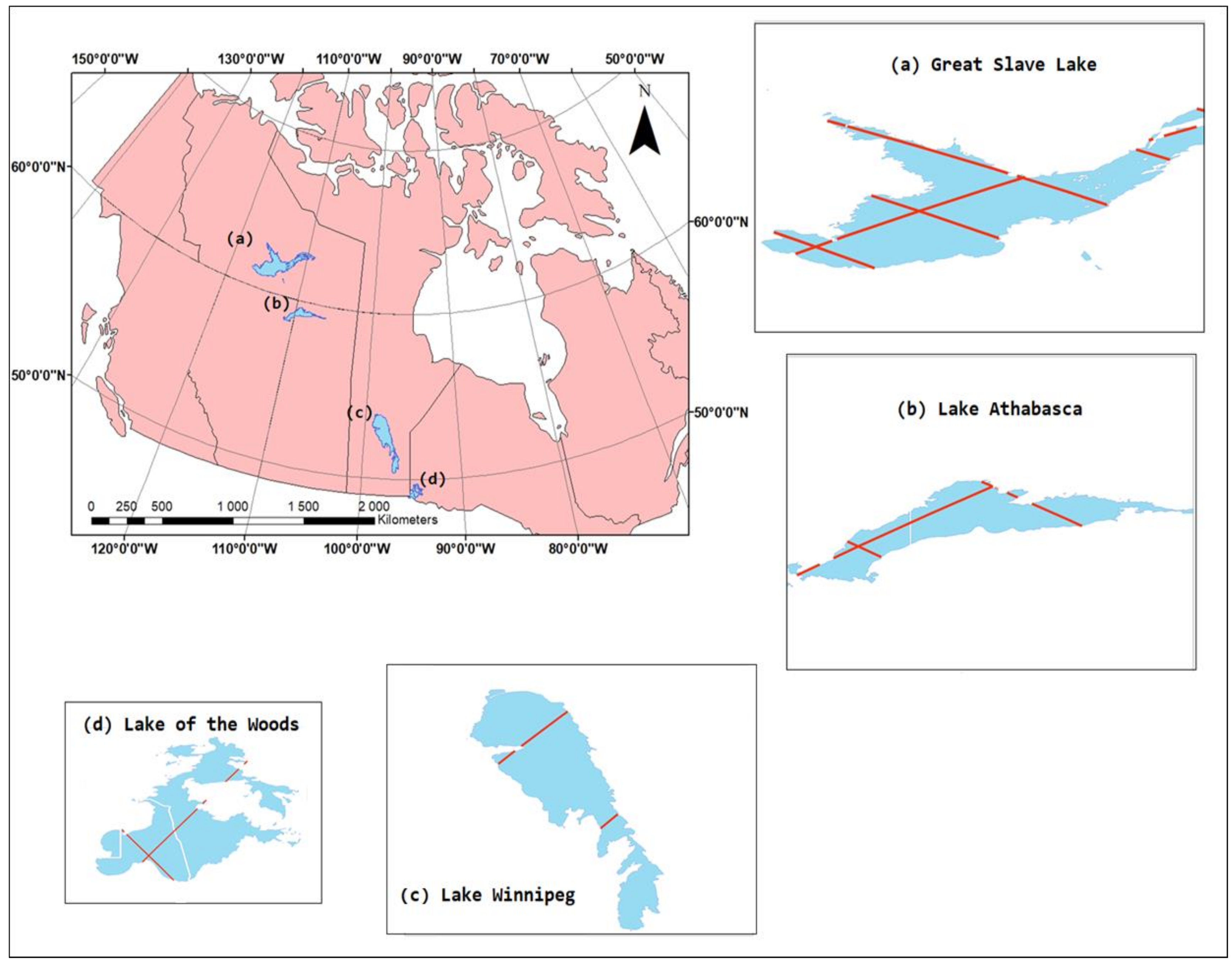
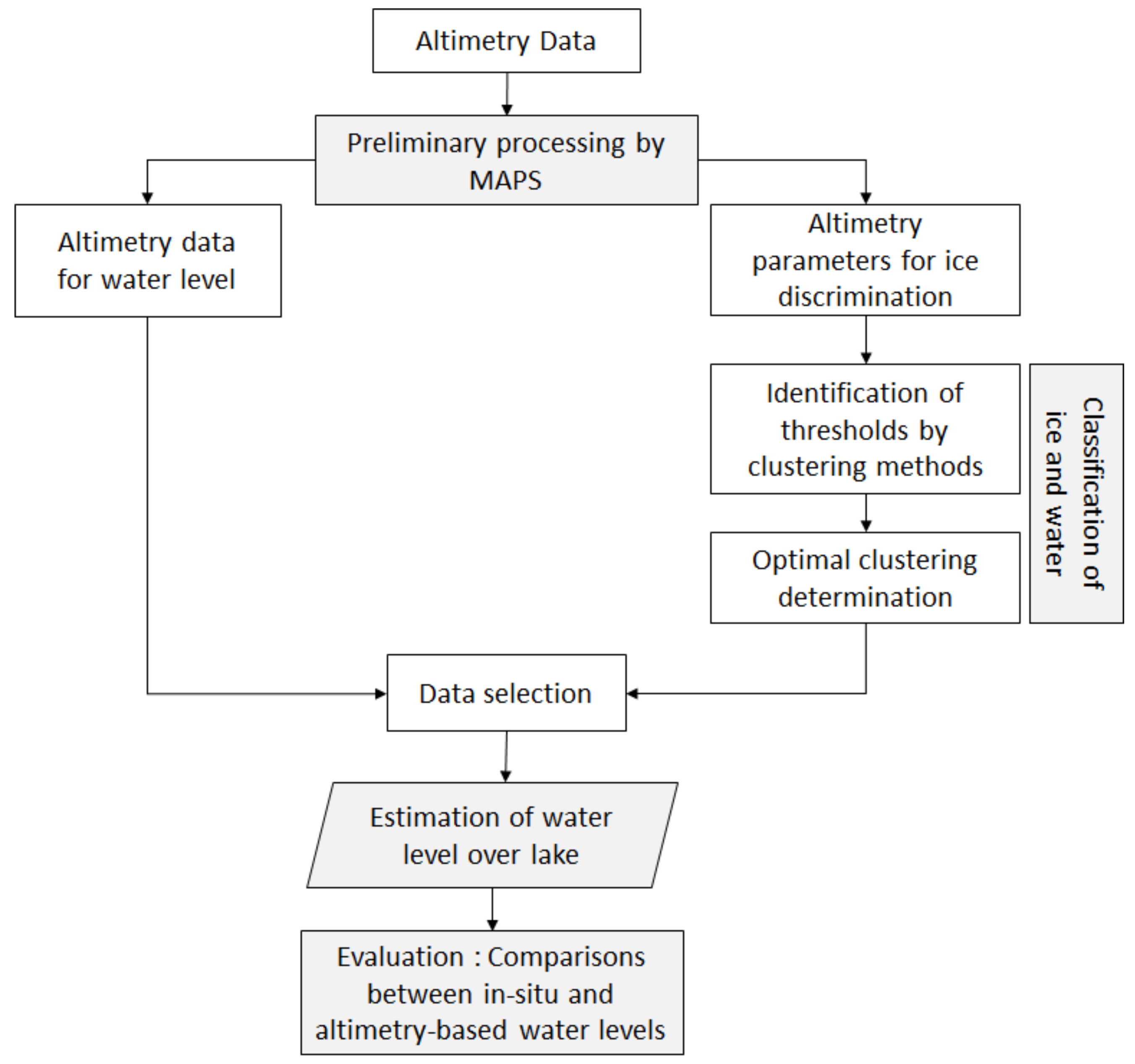
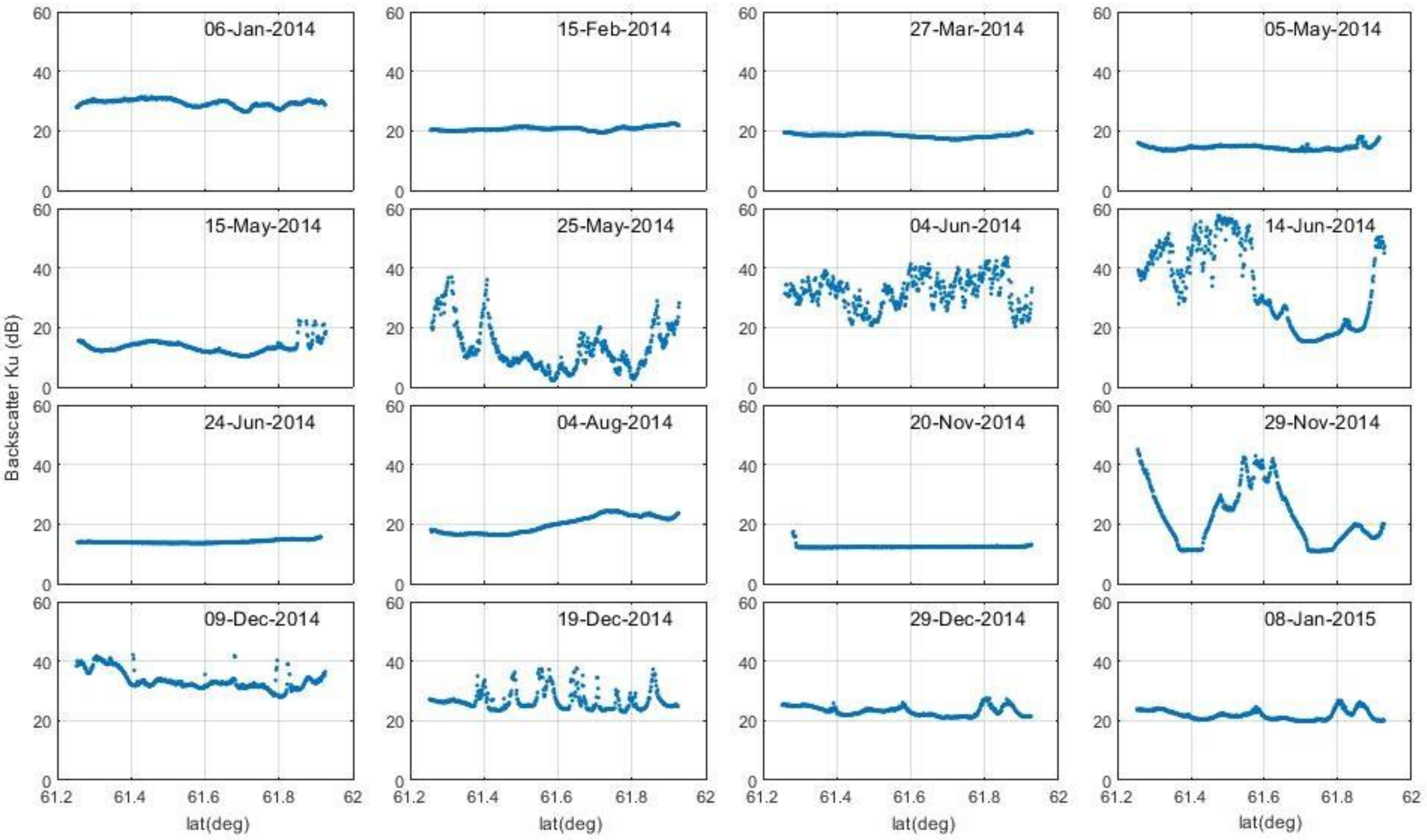
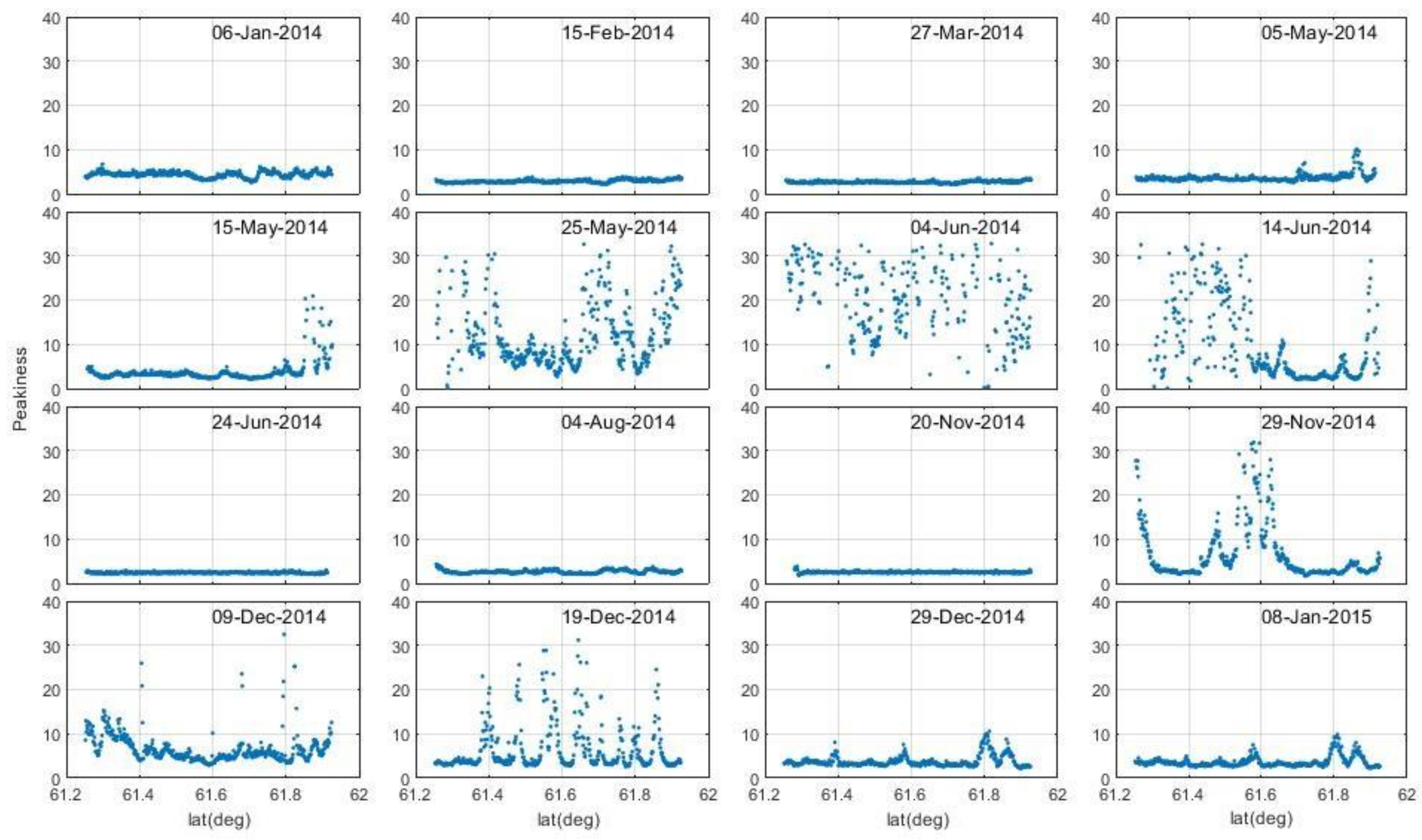
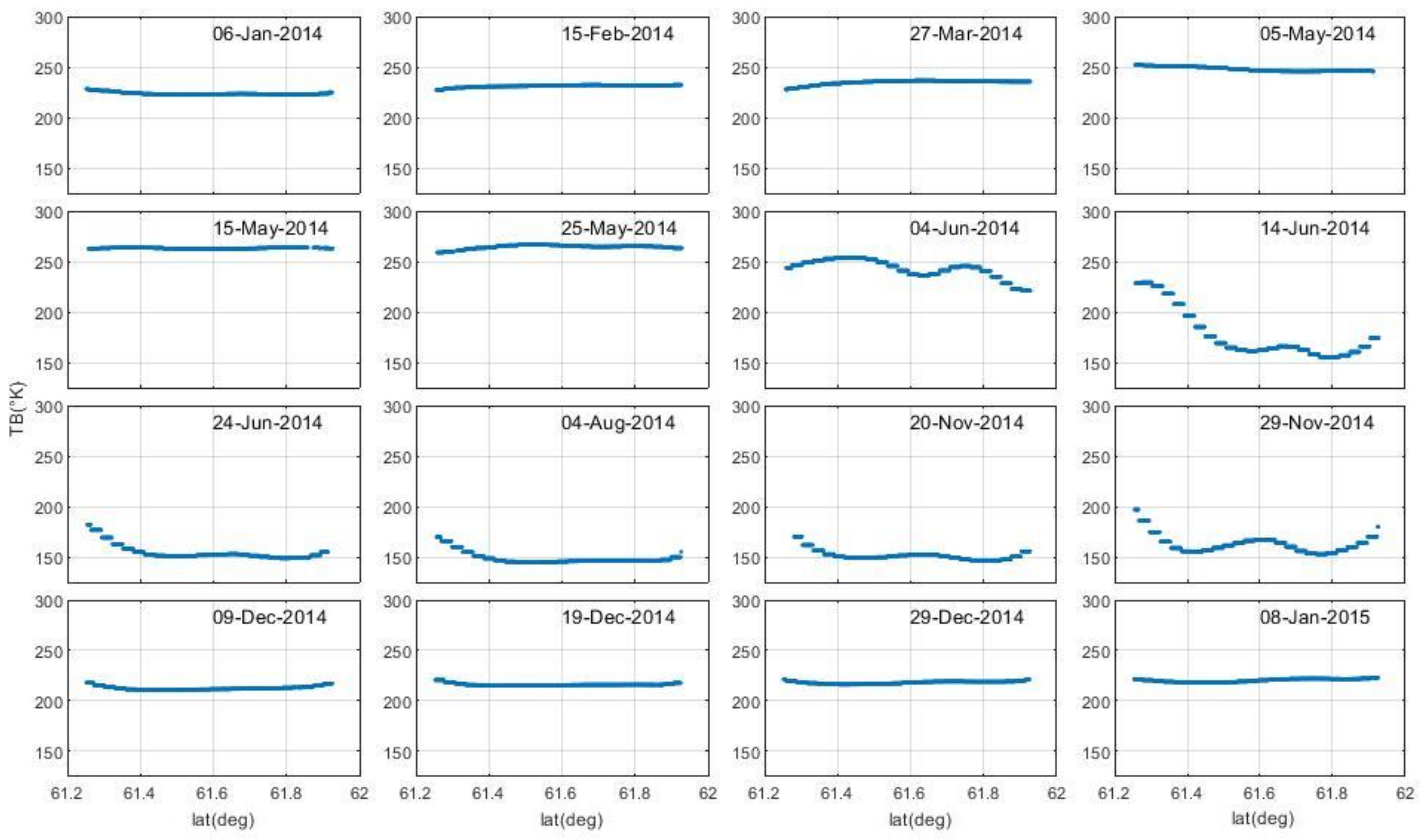


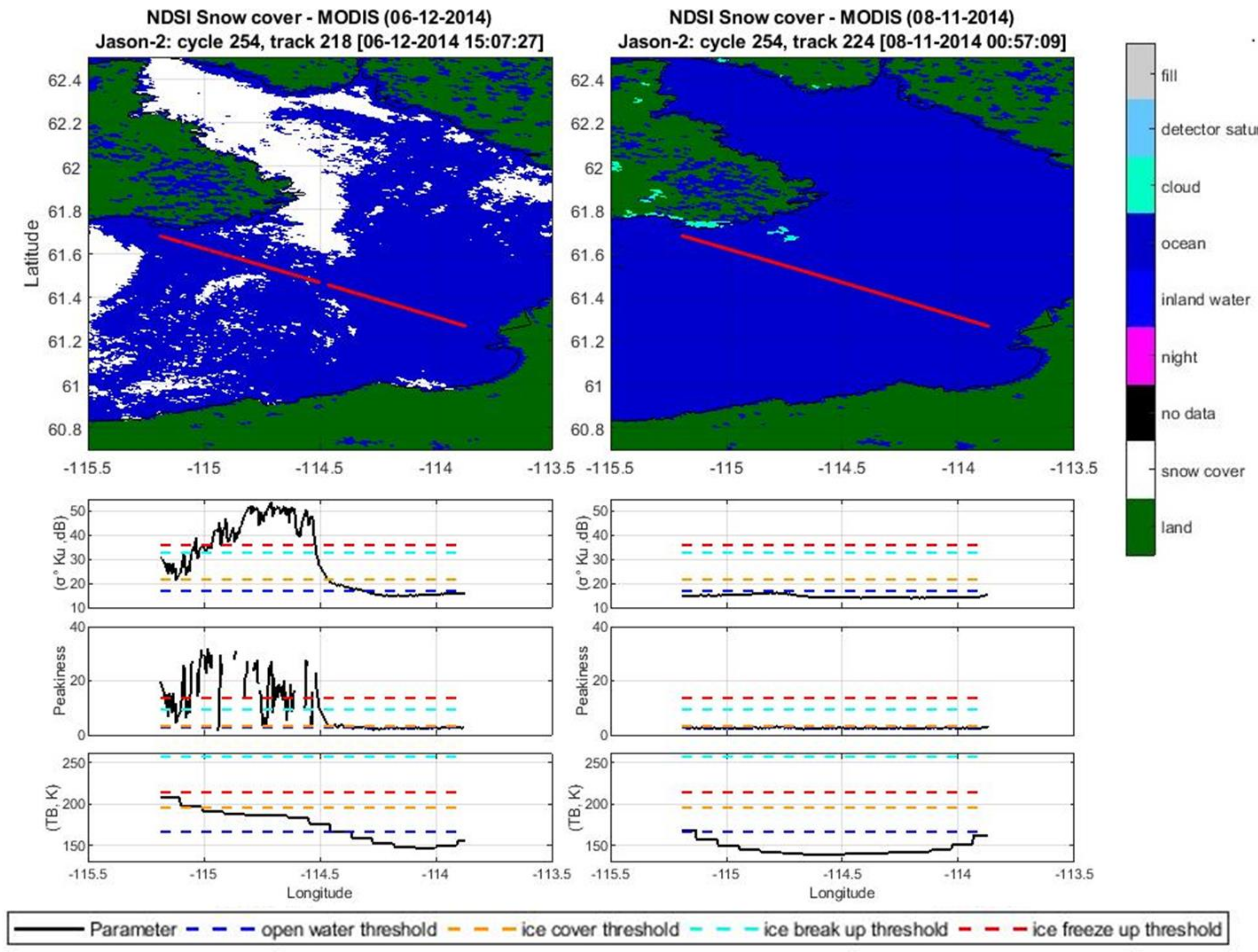
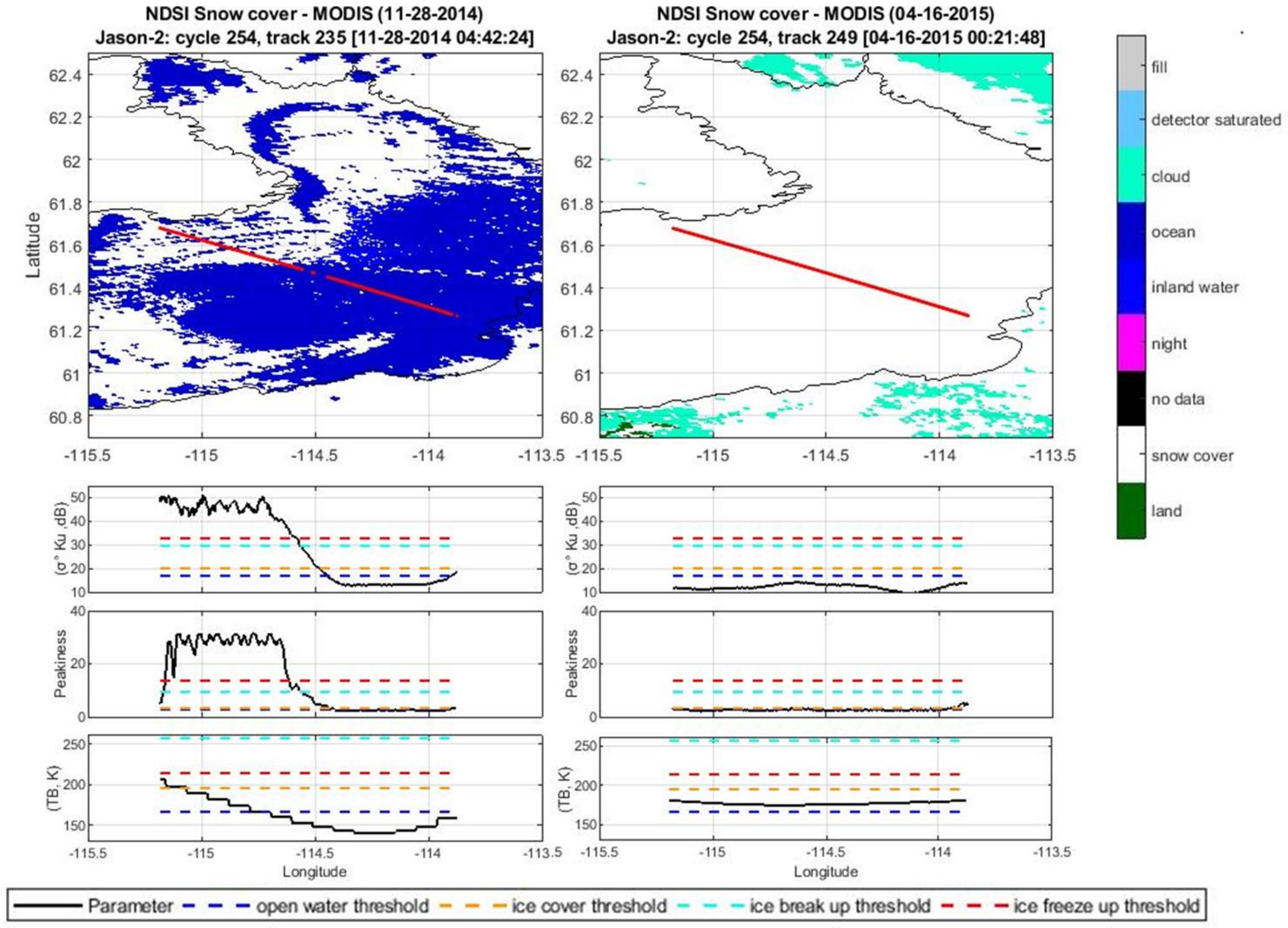

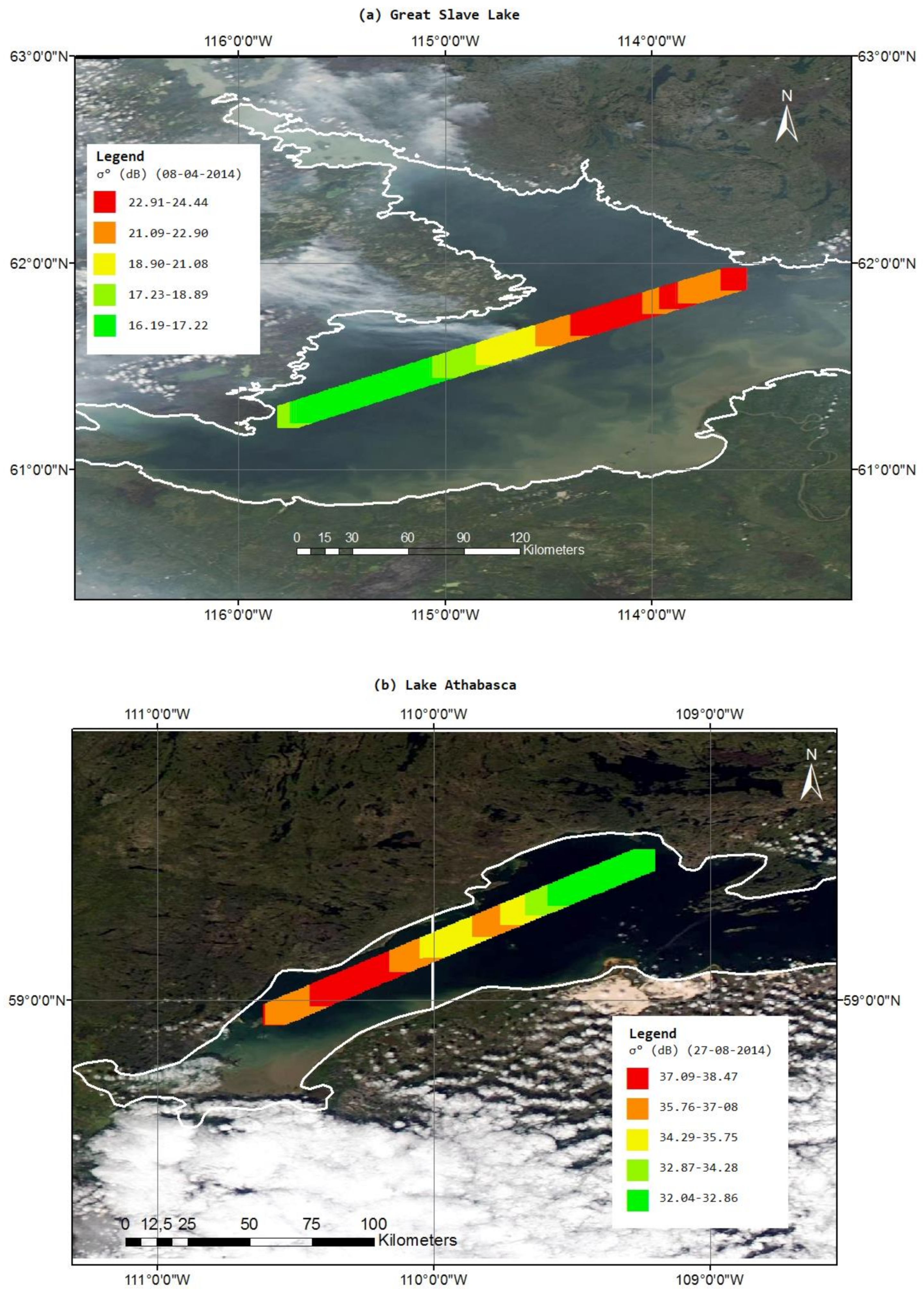
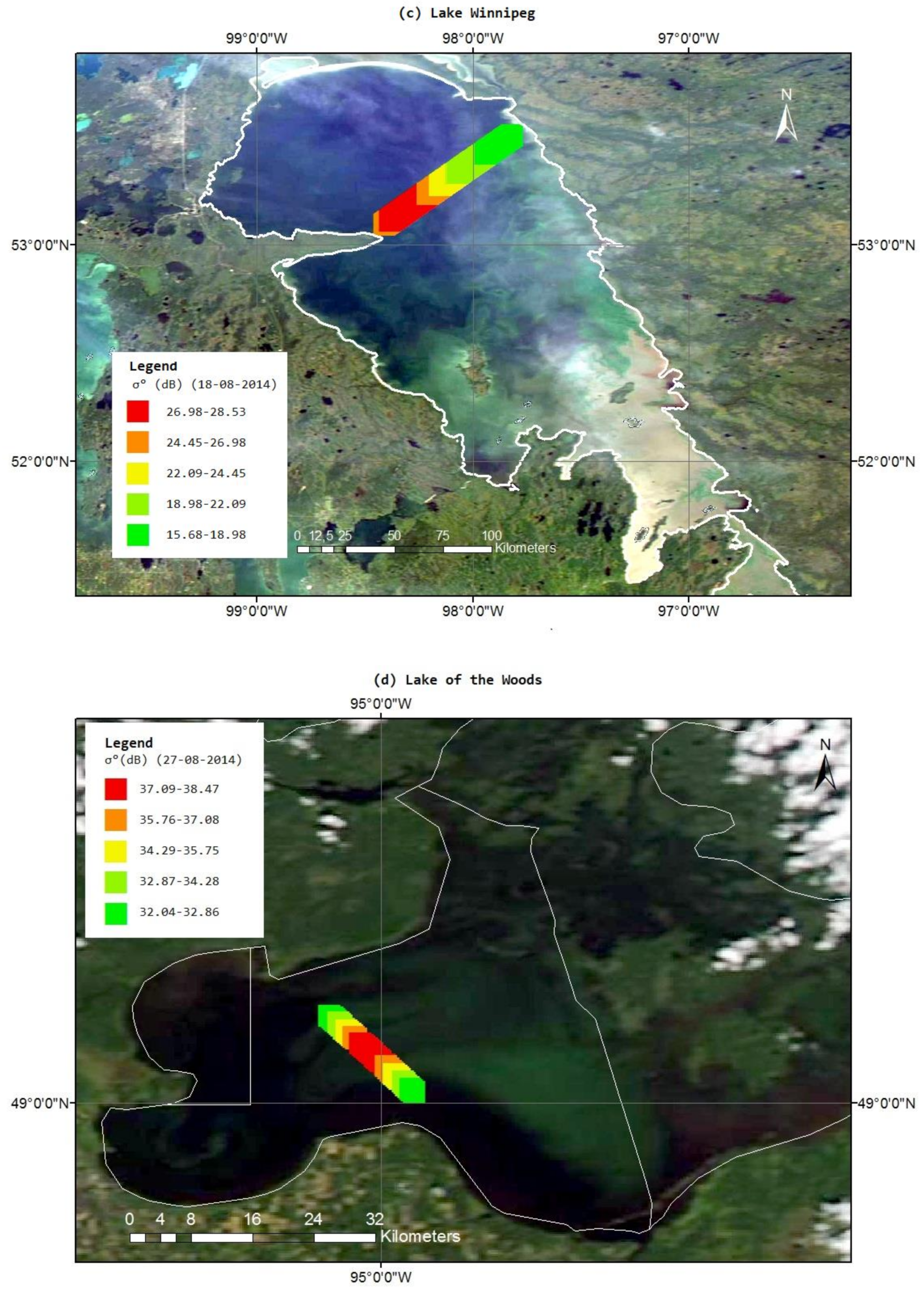
| Latitude | Longitude | Surface Area (km2) | Frozen Period* | Jason-2 (Track Number) | ||
|---|---|---|---|---|---|---|
| Ascending | Descending | |||||
| Great Slave Lake | 61°40′N | 114°W | 27200 | November to mid-June | #045 | #076, #152, #178, #254 |
| Lake Athabasca | 59°16′N | 109°27′W | 7850 | Late-November to mid-May | #095 | #178,#254 |
| Lake Winnipeg | 52°7′N | 97°15′W | 24514 | Mid-November to late-May | #195, #017 | - |
| Lake of the Woods | 49°14′59″N | 94°45′03″W | 4348 | December to May | #169 | #178 |
| Station Codes | Station Name | Location | ||
|---|---|---|---|---|
| Latitude | Longitude | |||
| Great Slave Lake | 07OB002 | Great Slave Lake at Hay River | 60°51′35.5″N | 115°44′3.1″ W |
| 07SB001 | Great Slave Lake at Yellowknife Bay | 62°26′29.6″ N | 114°20′59.3″ W | |
| Lake Athabasca | 07MC003 | Lake Athabasca Near Crackingstone Point | 59°23′4.0″ N | 108°53′34.5″ W |
| Lake Winnipeg | 05SA003 | Lake Winnipeg at Victoria Beach | 50°41′42.4″ N | 96°33′43.8″ W |
| 05SG001 | Lake Winnipeg at Mission Point | 53°11′28.0″ N | 99°12′43.1″ W | |
| 05RE003 | Lake Winnipeg at George Island | 52°49′6.3″ N | 97°37′10.4″ W | |
| Lake of the Woods | 05PD029 | Lake of the Woods at Cyclone Island | 49°19′42.2″ N | 94°51′12.2″ W |
| K-means | Hierarchical clustering | ||||||
|---|---|---|---|---|---|---|---|
| Cluster | σ° (dB) | peakiness | σ° (dB) | peakiness | |||
| Great Slave Lake | 1 | 17.1 (5.8) | 2.7 (1.2) | 165.6 (16.2) | 17.3 (6.2) | 2.8 (1.6) | 165.6 (10.5) |
| 2 | 21.8 (6.1) | 3.2 (1.4) | 195.6 (29.4) | 22.5 (6.5) | 3.4 (1.6) | 190.5 (29.2) | |
| 3 | 32.6 (8.4) | 9.2 (8.2) | 255.2 (17.5) | 32 (7.7) | 7.3 (7.4) | 251.5 (18.5) | |
| 4 | 35.9 (11.7) | 13.8 (8.3) | 213.9 (11.8) | 43.1 (5.3) | 18.1 (6.2) | 215.5 (11.1) | |
| Lake Athabasca | 1 | 15.2 (6.6) | 2.4 (1.8) | 172.8 (15.1) | 15.6 (3.4) | 3.7 (1.9) | 172.8 (15.3) |
| 2 | 17.4 (8.1) | 4.1 (4.1) | 196.5 (18.5) | 17.1 (3.7) | 4.2 (2.1) | 195.1 (18.2) | |
| 3 | 39.6 (9.3) | 10.3 (7.6) | 259.3 (26.1) | 37.7 (8.8) | 7.7 (2.6) | 248.1 (25.1) | |
| 4 | 33.7 (8.2) | 8.1 (5.5) | 236.3 (27.5) | 27.2 (8.5) | 8.3 (2.3) | 205.1 (25.2) | |
| Lake Winnipeg | 1 | 16.1 (5.6) | 2.8 (1.8) | 161.3 (26.1) | 15.9 (5.2) | 2.8 (1.8) | 162.7 (27.1) |
| 2 | 17.6 (7.3) | 3.5 (2.8) | 184.5 (16.6) | 18.8 (5.5) | 3.8 (1.3) | 185.7 (17.1) | |
| 3 | 32.4 (7.4) | 16.6 (6.1) | 242.9 (28.8) | 32.2 (7.5) | 16.5 (2.9) | 242.3 (29.2) | |
| 4 | 34.2 (9.6) | 12.1 (6.7) | 216.5 (25.9) | 34.1 (5.4) | 15.8 (4.9) | 216.8 (25.2) | |
| Lake of the Woods | 1 | 16.2 (7.7) | 2.9 (1.1) | 176.6 (14.2) | 15.1 (2.3) | 2.8 (1.4) | 192.7 (16.9) |
| 2 | 15.4 (3.4) | 2.9 (2.7) | 196.7 (26.6) | 17.1 (5.5) | 2.9 (1.1) | 174.1 (25.1) | |
| 3 | 21.1 (4.1) | 3.7 (6.1) | 226.6 (28.1) | 21.2 (5.5) | 7.5 (1.8) | 228.8 (11.1) | |
| 4 | 32.6 (3.9) | 7.3 (6.3) | 248.5 (26.8) | 31.8 (5.1) | 4.8 (1.6) | 234.4 (28.6) | |
| K-means | Hierarchical Clustering | ||
|---|---|---|---|
| Great Slave Lake | silhouette | 0.78 | 0.72 |
| Calinski-Harabasz (103) | 3.63 | 3.32 | |
| Lake Athabasca | silhouette | 0.78 | 0.73 |
| Calinski-Harabasz (103) | 1.55 | 1.50 | |
| Lake Winnipeg | silhouette | 0.78 | 0.71 |
| Calinski-Harabasz (103) | 1.67 | 1.25 | |
| Lake of the Woods | silhouette | 0.74 | 0.68 |
| Calinski-Harabasz (103) | 1.53 | 1.34 |
| Lake | Station Identification | Number of Match-ups | Estimator | Open Water Cluster | All Clusters |
|---|---|---|---|---|---|
| Great Slave Lake | 07SB001 | 809 | r | 0.93 | 0.83 |
| unRMSE (cm) | 9.1 | 11.1 | |||
| bias (cm) | 45.8 | 49.1 | |||
| 07OB002 | 897 | r | 0.94 | 0.84 | |
| unRMSE (cm) | 11.8 | 10.7 | |||
| bias (cm) | 37 | 42 | |||
| Lake Athabasca | 07MC003 | 559 | r | 0.97 | 0.93 |
| unRMSE (cm) | 11.3 | 18.7 | |||
| bias (cm) | 87.6 | 91.2 | |||
| Lake Winnipeg | 05RE003 | 595 | r | 0.89 | 0.78 |
| unRMSE (cm) | 16.4 | 22.1 | |||
| bias (cm) | 14.5 | 38.4 | |||
| 05SA003 | 535 | r | 0.83 | 0.74 | |
| unRMSE (cm) | 20.6 | 24.3 | |||
| bias (cm) | 23.4 | 29.1 | |||
| 05SG001 | 545 | r | 0.81 | 0.74 | |
| unRMSE (cm) | 20.8 | 24.7 | |||
| bias (cm) | 34 | 38 | |||
| Lake of the Woods | 05PD029 | 401 | r | 0.9 | 0.61 |
| unRMSE (cm) | 11.9 | 39.9 | |||
| bias (cm) | 11.8 | 12.3 |
© 2020 by the authors. Licensee MDPI, Basel, Switzerland. This article is an open access article distributed under the terms and conditions of the Creative Commons Attribution (CC BY) license (http://creativecommons.org/licenses/by/4.0/).
Share and Cite
Ziyad, J.; Goïta, K.; Magagi, R.; Blarel, F.; Frappart, F. Improving the Estimation of Water Level over Freshwater Ice Cover using Altimetry Satellite Active and Passive Observations. Remote Sens. 2020, 12, 967. https://doi.org/10.3390/rs12060967
Ziyad J, Goïta K, Magagi R, Blarel F, Frappart F. Improving the Estimation of Water Level over Freshwater Ice Cover using Altimetry Satellite Active and Passive Observations. Remote Sensing. 2020; 12(6):967. https://doi.org/10.3390/rs12060967
Chicago/Turabian StyleZiyad, Jawad, Kalifa Goïta, Ramata Magagi, Fabien Blarel, and Frédéric Frappart. 2020. "Improving the Estimation of Water Level over Freshwater Ice Cover using Altimetry Satellite Active and Passive Observations" Remote Sensing 12, no. 6: 967. https://doi.org/10.3390/rs12060967
APA StyleZiyad, J., Goïta, K., Magagi, R., Blarel, F., & Frappart, F. (2020). Improving the Estimation of Water Level over Freshwater Ice Cover using Altimetry Satellite Active and Passive Observations. Remote Sensing, 12(6), 967. https://doi.org/10.3390/rs12060967





